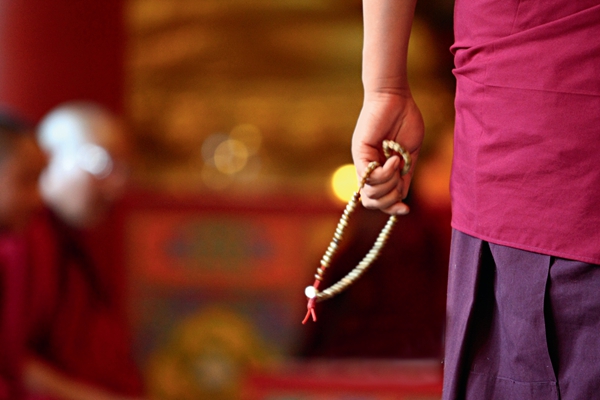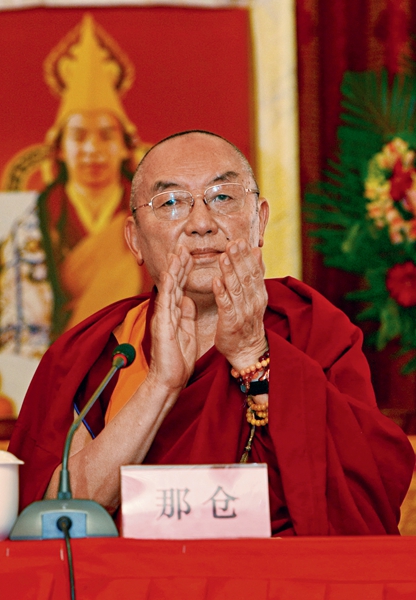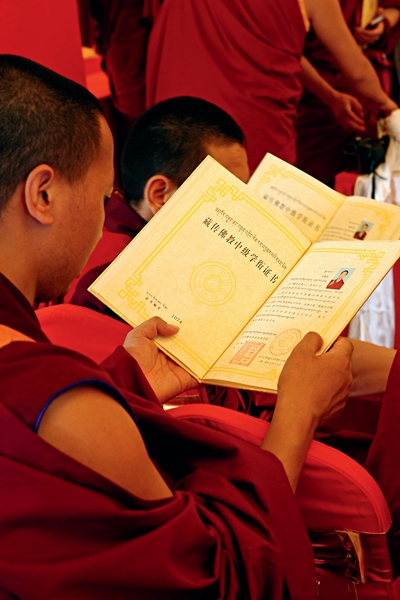By TSE YANG
By TSE YANG
THE very first class of students at the High-level Tibetan Buddhism College of China held their graduation ceremony one June morning in 1988, at Beijing’s Western Yellow Temple. The then president of the college, the 10th Panchen Lama, personally presented the first diploma to Nagtsang Jampa Ngawang.

This 48-year-old graduate had lived through drastic social changes and correspondingly changing roles. Soon after birth he was proclaimed a reincarnated soul boy, and grew up as a Living Buddha. From the 1950s to the 1970s, he suffered ignominy due to accusations of being counter-revolutionary. In 1980, he was rehabilitated and appointed president of the Buddhism Association in Garze, Sichuan Province, and in 1988, he took the post of vice president of the High-level Tibetan Buddhism College, a post he held for 30 years till his retirement.
Daily Life Practice
To Nagtsang, his life through to the present day has undergone three phases. The first was his childhood through till the age of 18, and his education, consisting in perception and thought of the Buddhist doctrine. Nagtsang was born in 1940 in Garze Tibetan Autonomous Prefecture, Sichuan Province. In 1943 he was identified as a reincarnated soul boy and the seventh Nagtsang Living Buddha. The enthronement ceremony took place in 1944 in Nagtsang Monastery of Garze.
According to the Tibetan Buddhist tradition, every Living Buddha has at least one, and possibly several mentors. Nagtsang’s mentor was Ngawang Chophel, a celebrated scholar in Garze Monastery. When he reached 12 years old, Nagtsang began studying Lamrim Chenmo, one of the most respected Tibetan Buddhist classics. This was the start of his study and practice of Tibetan Buddhism.

“Our secluded, tranquil monastery was the ideal setting for the study and practice of Buddhism. As a child, I kept company with no one other than my mentors and other monks. This laid solid foundations for my study. I have since cultivated a peaceful inner world. I’m 78 now, and still feel grateful for the time I was able to spend in that monastery. What I practice to this day is largely what I learned from the Lamrim Chenmo,” Nagtsang said.
The second phase of his life began in 1958, when he reached the age of 18. His status as a Living Buddha brought Nagtsang disgrace as a so-called counter-revolutionary.
Buddhists acknowledge that samsara – transmigration – means suffering. This is why achieving Buddhahood can happen only after a person has broken free of the cycle of transmigration, thus ridding themselves of the pain of earthly desires and disappointments and finding true happiness. Nagtsang said that he often practices what he learned from Lamrim Chenmo and his mentors in his daily life, and has so gradually formed his own understanding about the nature of life.
In 1980, he was rehabilitated, and his label as “counter-revolutionary” removed. This marked the third phase of his life, when he followed the 10th Panchen Lama’s bidding to continue studying and practicing the Buddhist doctrine.
Establishment of the College
The Buddhist Association of Gar-ze County was established in 1981, and Nagtsang was elected president. “We started our work equipped with a simple office desk and three chairs. There were 46 monasteries under our management. Through our efforts, 36 of them were reopened,” Nagtsang said.
In 1985, Nagtsang was transferred to the Buddhist Association of Garze Tibetan Autonomous Prefecture. While there he was invited to a meeting in Beijing organized by the Buddhist Association of China. What particularly impressed Nagtsang about the meeting was the speech delivered by the 10th Panchen Lama, then honorary president of the Buddhist Association of China.

“The 10th Panchen Lama proposed establishing a Tibetan Buddhism College, and explained why. He said that there had been no Living Buddhas in monasteries for about 30 years. Certain senior Living Buddhas had passed away. The younger ones that remained had not received systematic study, so were not qualified to work in contemporary monasteries. This is why he felt it necessary to establish a college where they could study,” Nagtsang recalled. In May 1987, Nagtsang was transferred to Beijing to assist in the establishment of a college of Buddhism.
Since its establishment in 1652, the Western Yellow Temple in Beijing has served as a bond between Tibet and the rest of China. It is where the fifth Dalai Lama stayed while visiting Beijing. After the sixth Panchen Lama passed away there in 1780, Emperor Qianlong of the Qing Dynasty (1644-1911) ordered the construction of a complex next to the temple that includes a pagoda where clothes and other items belonging to the sixth Panchen Lama are stored, along with the various endowments of the emperor. This temple is hence an eminently suitable site for a college of Buddhism.
During the preparatory work, Nagtsang was among those responsible for compiling textbooks. The group also included distinguished scholars such as Sharu Tong Rinpoche and Setsang Rinpoche. All have made significant contributions to the cultivation of Tibetan Buddhism practitioners since the reform and opening-up policy came into force. Through joint efforts, six textbooks had been compiled by the time the college opened. These include texts on fundamental Tibetan Buddhist theories, the origins of different sects, the history of Buddhism in Tibet Autonomous Region and Mongolia, monastery management, and the classics of different sects. The textbooks, their content and design, are highly esteemed in the Tibetology and Tibetan language publishing sectors.
In July 1987, two months before the college opened, Nagtsang traveled back to Sichuan Province to recruit students.
Vice President of the College
On September 1, 1987, the High-level Tibetan Buddhism College of China was officially established in the Western Yellow Temple in Beijing. The 10th Panchen Lama was appointed president of the college, and Zhao Puchu, at that time the president of the Buddhist Association of China, was appointed a senior consultant.
The first group of students was composed of 42 Living Buddhas. Nagtsang was the class monitor. The first four classes on Lamrim Chenmo were given personally by the 10th Panchen Lama. Sharu Tong Rinpoche continued with these lectures, which carried on for eight months.
As to why it is called a “high-level” college: “First, the college is in Beijing, capital of China. Second, the establishment and operation of the college is supported by the Chinese government. Third, its first president was the 10th Panchen Lama. And fourth, most of its students are Living Buddhas,” Nagtsang explained.
“The college was established under the guidance of religious policies formulated by the Central Committee of the Communist Party of China (CPC) and the State Council, and with the support of the United Front Work Department of the CPC Central Committee and State Administration for Religious Affairs. It was established under the proposal of the 10th Panchen Lama and Zhao Puchu. The purpose of establishing the college is to safeguard national unification and the unity of all ethnic groups, and to cultivate Buddhists who love our country and spread and pass on Tibetan Buddhism to future generations. In this way the college is intended as an educational and research center through which Tibetan Buddhism is inherited and spread. These were the Panchen Lama’s words at the college inauguration ceremony,” Nagtsang said.
After graduation, Nagtsang took the post of vice president of the college. He never expected that, just six months later, the 10th Panchen Lama would pass away, and he would carry on working at the college for another three decades. However, when the 10th Panchen Lama told him to stay in Beijing, he knew all he should do was to follow the Master’s bidding to devote himself to improving the system of education in Tibetan Buddhism.
In March 2003, the sixth Jamyang Living Buddha became the second president of the college, and in 2004, a new system of degrees at different levels was formally established. On September 1 of that year, the opening ceremony for students taking part in the Tho Ram Pa advanced degree program was held. All passed their examinations and received their degrees in October 2005.
In 2011, the college set up a panel of judges to assess the qualifications of lecturers of Tibetan Buddhism, and to select those best qualified. In October 2013, the college organized the Nzhing Ram Ba (middle-level degree) examination. A total of 61 students of different sects of Tibetan Buddhism from Tibet and Tibetan-inhabited areas of Sichuan Province passed the examinations, which included sutra debating and dissertation defense, and so obtained their degrees.
“We estimate that cultivating a student for an advanced degree comes at a cost of about RMB 400,000. About 120 to 130 students have obtained advanced degrees, and about 20 students at the college are now studying for such degrees,” Nagtsang said.
Over the past 30 years, the college has cultivated groups of Living Buddhas and eminent monks of various sects of Tibetan Buddhism. Some have gone on to take leading positions in their respective regions and monasteries, some become teachers, and others establish hospitals or schools. All the Living Buddhas and eminent monks who have graduated from the college play an active role in boosting the stability and development of Tibet and Tibetan-inhabited areas around China.
A Life-long Practice
Now 78 years old, Nagtsang has carried out his mentor’s wish and worked at the college for the past three decades. Unlike certain other Living Buddhas who have their staffs, Nagtsang depends on himself, and allocates all donations received from believers to the construction and renovation of monasteries.
“To do no evil, to cultivate good, to purify one’s mind, this is the teaching of the Buddha.” For Nagtsang, whether or not a religion can achieve sustainable development relies on its followers. Just as the 10th Panchen Lama said, “The monasteries should be what monasteries are supposed to be, and the monks should be what monks are supposed to be.”
Last year, Nagtsang applied for retirement. “I think it’s time for one of the eminent graduates of our college to do my job and assume its responsibilities. I have fulfilled my mentor’s wish and done what I can, although I haven’t made any great contributions. I think my life-long practice is to combine what I do, what I say, and what I think with the Buddhist doctrine, like mixing milk with tea,” Nagtsang said.
TSE YANG is a reporter with Tibet.cn.